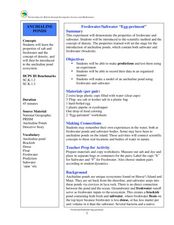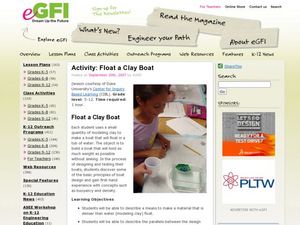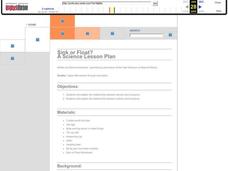Curated OER
Thermo and Fluid Dynamics of a Homemade "Lava Lamp"
High schoolers construct their own lava lamp using simple substances. In this physics lesson, students explain how difference in density causes convection. They solve for forces and buoyancy using mathematical equations.
Curated OER
What Floats Your Boat?
Learners are introduced to the concept of buoyancy. The Video used in this lesson demonstrates and explains the characteristics of objects that sink and float. It presents the concepts of displacement, weight, and buoyancy.
Curated OER
Buoyant Boats
Learners design and construct a boat out of aluminum foil and a few other simple materials. The boats then be tested by floating them in water, then adding mass until they sink. They explore the various shapes of boat construction.
Curated OER
I've Got That Sinking Feeling
Students design a simple boat and predict how much weight it can carry. They should also discover why objects float or sink and how this can be determined experimentally. A great lesson on buoyancy!
Curated OER
Freshwater/Saltwater "Eggs-Periment"
Students explore water properties by conducting a class experiment. In this buoyancy lesson plan, students utilize freshwater, saltwater, plastic cups, hard boiled eggs and food coloring to experiment with the floating capabilities of...
Curated OER
Floating and Falling Flows
Students discover fluid dynamics related to buoyancy through experimentation and optional photography. Using one set of fluids, they make light fluids rise through denser fluids. Using another set, they make dense fluids sink through a...
Curated OER
Build Your Own Submarine
Students construct their own submarine following a certain procedure. In this physics lesson, students calculate the density of objects using a mathematical formula. They explain why some object floats in water while some do not.
Teach Engineering
What Floats Your Boat?
Clay's as good a material as any to build a boat, right? An introductory lesson sets the stage for two activities associated with buoyancy. The first involves building boats out of clay, while the second uses these boats to measure the...
Center for Learning in Action
Properties of Balls
Enhance your states of matter lessons with a hands-on science investigation that compares six different balls' color, texture, size, weight, ability to bounce, and buoyancy.
Discovery Education
Future Fleet
Turn your pupils into engineers who are able to use scientific principals to design a ship. This long-term project expects pupils to understand concepts of density, buoyancy, displacement, and metacenter, and apply them to constructing a...
University of Southern California
Design and Test an Air Lift Siphon
Build an air lift siphon using your mad physics skills! Learners first investigate the importance of circulating water in aquaponics systems. They then use density to their advantage as they engineer an air lift siphon
Curated OER
Cold Hard Facts...What Inquiring Minds Will Know
Learners work with "ice" in order to gain a practical application of math concepts that evolve into an inquiry-based study. They determine if the dimensions of the ice make a difference in the way the ice floats in the water.
Curated OER
Activity: Float a Clay Boat
Written to introduce pupils to buoyancy, this activity has collaborative groups work to design a floatable clay boat. They first observe that a stick of clay sinks in water and then are given their own stick to reshape into a floating...
Curated OER
The Weight of Water
Students examine how salt water is more dense than fresh water. They discuss how manatees need to float and sink, conduct a sink or float experiment, and conduct an experiment with eggs and salt and fresh water.
Curated OER
The Buoyancy Factor
Students examine why some objects float in water while others sink and the ability of something to float does not depend entirely on its weight. Archimedes' principle is introduced and buoyant force is discussed. Practice calculations...
Curated OER
Secrets Beneath the Waters
Students work in small groups and design a ship out of balsa wood. They hypothesize what happens when the ship is placed in water then make predictions as to which ship stays afloat the longest with the greatest amount of weight added.
Curated OER
Water Density and Stability Lab
Students observe how different water densities and salinity control the depth at which different water masses occur. Submarines are used as a case study. This is a well-designed with an excellent worksheet.
Institute of Electrical and Electronics Engineers
Life Vest Challenge
After reading about the history and science of personal floatation devices, patents, and intellectual property, engineering teams design a life vest for a can of soup. To evaluate which groups considered the need for waterproofing, hold...
Curated OER
Physical Science- Sink or Float?
Learners investigate which objects sink and which ones float. Learners engage in an experiment, make predictions, and record results on a graphic organizer. This is a comprehensive and easy to follow resource.
Institute of Electrical and Electronics Engineers
Can You Canoe?
A neat handout immerses learners in the history of canoe making. After reading, small groups of mini engineers work to craft a canoe that will not be immersed! This is an ideal exercise in engineering design for your STEM curriculum or...
Curated OER
Sink or Float?
Students analyze the relationship between density, buoyancy, and salinity. In this chemical properties instructional activity, students read a background activity for the instructional activity and experiments to the topics. Students...
Curated OER
How Does the USS Alabama Float?
Students investigate buoyancy. For this buoyancy lesson, students apply the Archimedes Principle of Buoyancy to the experiment conducted in class to determine how battleships float.
Curated OER
Archimedes' Principle
Students examine the relationship between density and buoyancy. In this physics lesson students use Archimedes' Principle to complete calculations on buoyancy and a lab activity.
Curated OER
Dive In
Learners study how buoyancy, pressure, and light can effect the work of underwater scientists. In this marine science lesson students complete a lab that allows them to better understand how pressure varies with altitude and depth.
























